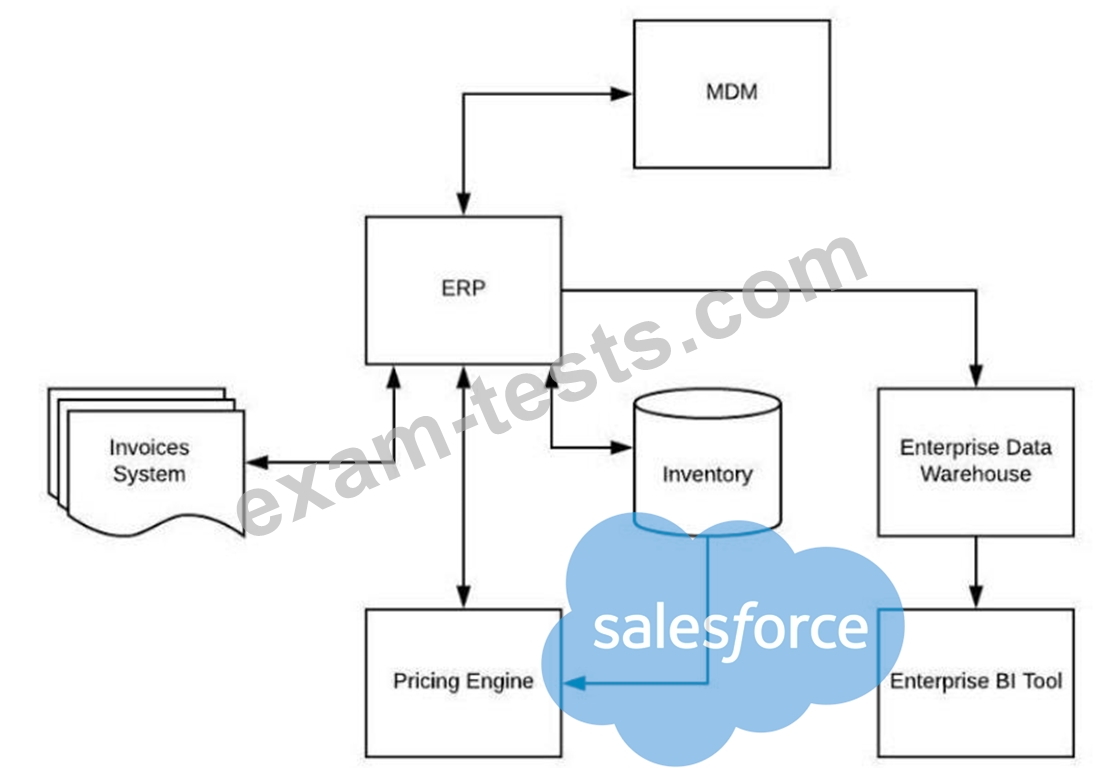Question 1
A large enterprise customer with the following system landscape is planning to implement Salesforce Sales Cloud.

The following business processes need to be supported in Salesforce:
1. Sales Consultants should be able to have access to current inventory.
2. Enterprise Resource Planning System(ERP) is the system of record for pricing information.
3. Quotes should be generated in Salesforce with pricing from ERP.
4. Sales Management uses a Enterprise Business Intelligence (BI) tool to view Sales dashboards.
5. Master Data Management (MDM) is the system of record for customers and prospects.
6. Invoices should be accessible in Salesforce.
Which systems in the landscape should the Integration Consultant consider to be integrated with Salesforce to support the business requirements?

The following business processes need to be supported in Salesforce:
1. Sales Consultants should be able to have access to current inventory.
2. Enterprise Resource Planning System(ERP) is the system of record for pricing information.
3. Quotes should be generated in Salesforce with pricing from ERP.
4. Sales Management uses a Enterprise Business Intelligence (BI) tool to view Sales dashboards.
5. Master Data Management (MDM) is the system of record for customers and prospects.
6. Invoices should be accessible in Salesforce.
Which systems in the landscape should the Integration Consultant consider to be integrated with Salesforce to support the business requirements?
Question 2
Northern Trail Outfitters (NTO) has recently changed their Corporate Security Guidelines. The guidelines require that all cloud applications pass through a secure firewall before accessing on-premise resources. NTO is evaluating middleware solutions to integrate cloud applications with on-premise resources and services.
What are two considerations an Integration Architect should evaluate before choosing a middleware solution?
Choose 2 answers
What are two considerations an Integration Architect should evaluate before choosing a middleware solution?
Choose 2 answers
Question 3
Northern Trail Outfitters is planning to perform nightly batch loads into Salesforce from an external system with a custom Java application using the and the CIO is curious about monitoring recommendations for the jobs from the Technical Architect Which two recommendations will help meet the requirements?
Choose 2 answers
Choose 2 answers
Question 4
A company has an external system that processes and tracks orders. Sales reps manage their leads and opportunity pipeline in Salesforce. In the current state, the two systems are disconnected and processing orders requires a lot of manual entry on sales rep part. This creates delays in processing orders and incomplete data due to manual entry.
As a part of modernization efforts the company decided to integrate Salesforce and the order management system. The following technical requirements were identified:
1. Orders need to be created in real time from salesforce
2. Minimal customization*, and code should be written due to a tight timeline and lack of developer resources
3. Sales reps need to be able to see order history and be able to see most up to date information on current order status.
4. Managers need to be able to run reports in Salesforce to see daily and monthly order volumes and fulfillment timelines.
5. The legacy system is hosted on premise and is currently connected to the Enterprise Service Bus (ESB). The ESB is flexible enough to provide any methods and connection types needed by salesforce team.
6. There are 1000 sales reps. Each user processes/creates on average 15 orders per shift. Most of the orders contain 20-30 line items.
How should an integration architect integrate the two systems based on the technical requirements and system constraints?
As a part of modernization efforts the company decided to integrate Salesforce and the order management system. The following technical requirements were identified:
1. Orders need to be created in real time from salesforce
2. Minimal customization*, and code should be written due to a tight timeline and lack of developer resources
3. Sales reps need to be able to see order history and be able to see most up to date information on current order status.
4. Managers need to be able to run reports in Salesforce to see daily and monthly order volumes and fulfillment timelines.
5. The legacy system is hosted on premise and is currently connected to the Enterprise Service Bus (ESB). The ESB is flexible enough to provide any methods and connection types needed by salesforce team.
6. There are 1000 sales reps. Each user processes/creates on average 15 orders per shift. Most of the orders contain 20-30 line items.
How should an integration architect integrate the two systems based on the technical requirements and system constraints?
Question 5
Northern Trail Outfitters (NTO) has recently implemented middleware for orchestration of services across platforms. The ERP system being used requires transactions be captured near real time at a REST endpoint initiated in Salesforce when creating an order object. Additionally, the Salesforce team has limited development resources and requires a low code solution.
Which two options will fulfill the use case requirements?
Choose 2 answers
Which two options will fulfill the use case requirements?
Choose 2 answers

